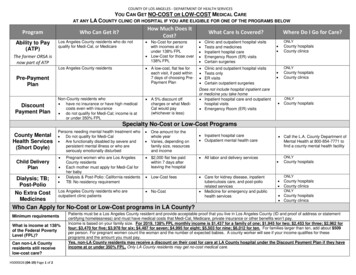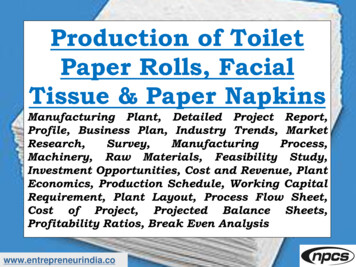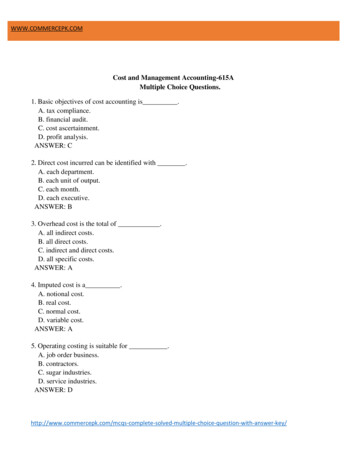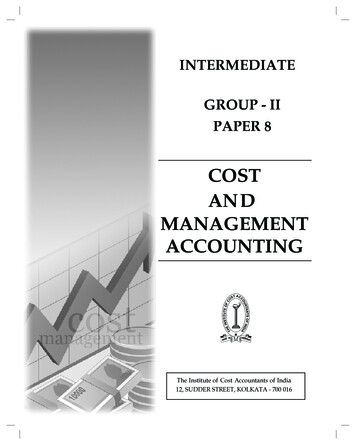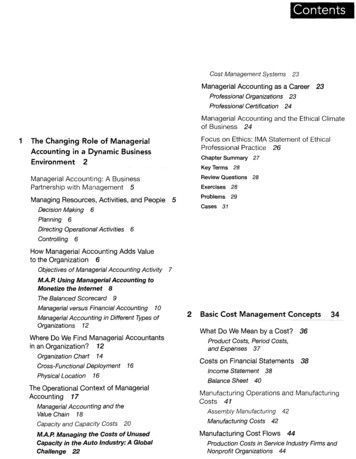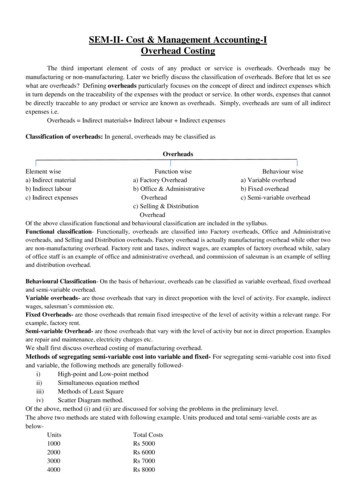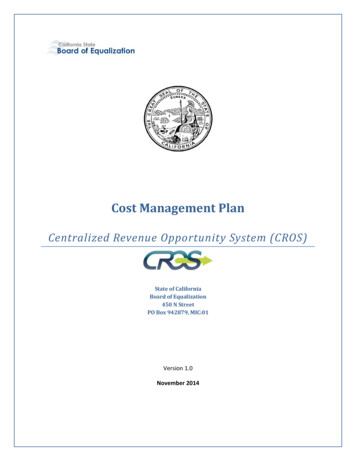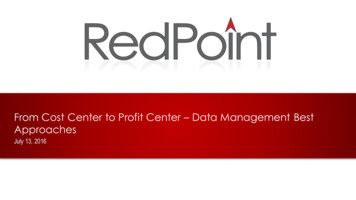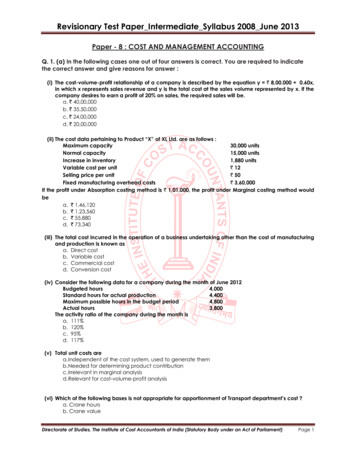
Transcription
Revisionary Test Paper Intermediate Syllabus 2008 June 2013Paper - 8 : COST AND MANAGEMENT ACCOUNTINGQ. 1. (a) In the following cases one out of four answers is correct. You are required to indicatethe correct answer and give reasons for answer :(i) The cost-volume-profit relationship of a company is described by the equation y 8,00,000 0.60x,in which x represents sales revenue and y is the total cost at the sales volume represented by x. If thecompany desires to earn a profit of 20% on sales, the required sales will be.a. 40,00,000b. 35,50,000c. 24,00,000d. 20,00,000(ii) The cost data pertaining to Product “X” of XL Ltd. are as follows :Maximum capacity30,000 unitsNormal capacity15,000 unitsIncrease in inventory1,880 unitsVariable cost per unit 12Selling price per unit 50Fixed manufacturing overhead costs 3,60,000If the profit under Absorption costing method is 1,01,000, the profit under Marginal costing method wouldbea. 1,46,120b. 1,23,560c. 55,880d. 73,340(iii) The total cost incurred in the operation of a business undertaking other than the cost of manufacturingand production is known asa. Direct costb. Variable costc. Commercial costd. Conversion cost(iv) Consider the following data for a company during the month of June 2012Budgeted hours4,000Standard hours for actual production4,400Maximum possible hours in the budget period4,800Actual hours3,800The activity ratio of the company during the month isa. 111%b. 120%c. 95%d. 117%(v) Total unit costs area. Independent of the cost system, used to generate themb. Needed for determining product contributionc. Irrelevant in marginal analysisd. Relevant for cost-volume-profit analysis(vi) Which of the following bases is not appropriate for apportionment of Transport department’s cost ?a. Crane hoursb. Crane valueDirectorate of Studies, The Institute of Cost Accountants of India (Statutory Body under an Act of Parliament)Page 1
Revisionary Test Paper Intermediate Syllabus 2008 June 2013c. Truck Mileaged. Truck value(vii) The cost of obsolete inventory acquired several years ago, to be considered in a keep vs. disposaldecision is an example of :a. Uncontrollable costb. Sunk costc. Avoidable costd. Opportunity cost(viii) Budgeted sales for the next year is 5,00,000 units. Desired ending finished goods inventory is 1,50,000units and equivalent units in ending W-I-P inventory is 60,000 units. The opening finished goodsinventory for the next year is 80,000 units, with 50,000 equivalent units in beginning W-I-P inventoryHow many equivalent units should be produced ?a. 5,80,000b. 5,50,000c. 5,00,000d. 5,75,000(ix) If the asset turnover and profit margin of a company are 1.85 and 0.35 respectively, the return oninvestment isa. 0.65b. 0.35c. 1.50d. 5.29(x)A company is currently operating at 80% capacity level. The production under normal capacity levelis 1,50,000 units. The variable cost per unit is 14 and the total fixed costs are 8,00,000. If thecompany wants to earn a profit of 4,00,000, then the price of the product per unit should bea. 37.50b. 38.25c. 24.00d. 35.00Answer 1.(i) – a.Variable cost 60% , therefore, contribution to sales ratio 40% (P/V ratio)Company’s target profit 20% in sales, therefore, revised contribution which covers only fixed cost 40% 20% 20%.Required sales fixed cost / revised contribution 8,00,000/ 20% 40,00,000](ii) – c.Fixed cost per unit 3,60,000 / 15,000 units 24Profit under absorption costing 1,01,000Adjustment of fixed manufacturing overhead costs of increased inventory 1,880 units x 24 45,120Profit under marginal costing 1,01,000 – 45,120 55,880](iii) – c.(iv) – a.Activity ratio Standard hours for actual productionBudgeted hours 4,440 hours x 100 111%4,000 hours(v) – c.x 100Directorate of Studies, The Institute of Cost Accountants of India (Statutory Body under an Act of Parliament)Page 2
Revisionary Test Paper Intermediate Syllabus 2008 June 2013(vi) – b.(vii) – b - Costs of obsolete inventory represent the sunk cost because the costs have already beenincurred.(viii) – a.Using production related budgets, units to produce equals budgeted sales desired ending finished goodsinventory desired equivalent units in ending W-I-P inventory – beginning finished goods inventory –equivalent units in beginning W-I-P inventory. Therefore, in this case, units to produce is equal to 5,00,000 1,50,000 60,000 – 80,000 – 50,000 5,80,000.(ix) – a - Return on investment Asset turnover x Profit margin 1.85 x 0.35 0.65(x) – c.Total fixed cost 8,00,000Expected profit 4,00,000Variable cost at 80% level(80% x 1,50,000 units x 14) 16,80,000Total price 28,80,000Per unit price at 80% level ( 28,80,000 / 1,20,000 units) 24.00.Q. 2. Write short notes on :(i)Value Analysis(ii)Application of service costing(iii)Cost benefit analysis(iv)Cost Indifference Point(v)Incremental PricingAnswer 2.(i) Value Analysis : It is one of the important tools of modern management in the area ofcost reduction. It is also known by other names such as value engineering, value control andproduct research. Value analysis is the process of systematic analysis and evaluation of varioustechniques and functions with a view to improve organisational performance. It aims atreducing and controlling the cost of a product from the point of view of its value by analysingthe value currently received. It investigates into the economic attributes of value analysis,believes in a planned action to improve performance and thereby, generates higher value in aproduct and ultimately causes reduction in its cost.The meaning of the term value may vary from person to person, time to time and place toplace. However, in the context of cost reduction and control it refers to the ‘use value’.The reduction in the costs of a product and thus increasing the profitability of a concern is themain advantage of value analysis.The benefits of value analysis are being derived in many industries, e.g., engineering, buildingconstruction and the oil industry. It is being applied to components of a product, finishedproduct and also to be methods of packaging.The various steps involved in value analysis are;a)Identification of the problem;Directorate of Studies, The Institute of Cost Accountants of India (Statutory Body under an Act of Parliament)Page 3
Revisionary Test Paper Intermediate Syllabus 2008 June 2013b)Collecting information about the function, design, material, labour, overhead costs,etc., of the product and finding out the availability of the competitive products in themarket; andc)Exploring and evaluating alternatives and developing them.(ii)Application of service costingThe service costing is applied in the following situations :a) Internal service departments – Service costing is applied to the operations concernedin an organization which provide services to production departments. For example,Canteen for the staff, Hospital for the staff, boiler house of supplying steam toproduction departments, Captive Power generation unit, operation of fleet ofvehicles for transport of raw material to factory or distribution of fi nished goods to themarket outlets, computer department services used by other departments etc.b) Service organizations – When services are offered to outside customers with a profitmotive and it is the business of the organisation in offering services, lik e Transportorganization, Hotel business, Power generation company etc., service costing isapplied.(iii) In order to create more wealth by reducing costs, it is absolutely essential to be able todifferentiate between necessary and unnecessary costs. If you try to reduce the necessary costs,you almost certainly reduce the benefits created by the resources being consumed. This kind ofcost reduction leads to lower than required quality, extended delivery periods, increasedrejections from inadequate materials and so on. The only really effective way of increasing thewealth created by the company is to search out and eliminate all unnecessary costs.There are five steps involved in establishing the benefits created by resources consumed in thebusiness.Step 1 – Cost AnalysisThis involves an analysis of all costs and activities. This can usually be done from any reasonablydesigned accounting system.Step 2 – Contribution AnalysisAnalyzing the value of what each activity contributes in terms of income or benefits is importantin establishing the real wealth-creating activities of the business.Step-3 – Benefit AnalysisTrying to decide on the benefits provided by the service and control activities is no easy matter.It is very much an attitude of mind, based on asking questions. It is vital to break down costs onthe basis of the reasons why they are incurred, and then to assess the benefits.Step 4 – Cost ReductionDevelop a cost-reduction programme by establishing those reasons for incurring cost which :a) Do not contribute to an activity’s earning potentialb) Do not contribute adequately to the activity’s earning potential.c) Do not create benefits.d) Do not create adequate benefits for the level of cost.Step 5 – Profit ImprovementDevelop a profit improvement programme by determining those areas which can createadditional income from existing and new resources, based on rationalization and reduced costsof existing activities.(iv) Cost Indifference Point – A cost indifference point is the point at which total cost (Fixedcost and variable cost) of two alternatives under consideration is the same. A company mayhave two methods available for production and it may so happen that at lower levels of activityone method is suitable up to a particular point and beyond that another method is suitable. TheDirectorate of Studies, The Institute of Cost Accountants of India (Statutory Body under an Act of Parliament)Page 4
Revisionary Test Paper Intermediate Syllabus 2008 June 2013question arises at what level of capacity choice shifts from one production method to anotherproduction method. This point is called cost indifference point and at this point total cost isidentical for the two alternatives. Cost indifference point will occur at a point where :Total cost of alternative A Total cost of alternative BCost indifference points are useful in analyzing many types of alternative choice decisions suchas choosing between alternative production methods, marketing plans or quality controlprogrammes.(v)Incremental Pricing involves comparison of the impact of decisions on revenuesand cost. If a pricing decision results in a greater increase in revenue than in costs, it isfavourable. Profitability is identified as the primary consideration and then the decision isadjusted to bring it in consonance with the other decisions of the business.Incremental pricing analyses all aspects of decision-making as listed below :a)Relevant cost analysis – This technique considers changes in costs rather than inAverage Cost. Overhead allocations are irrelevant. Incremental revenue inflows and Costoutflows are included for decision-making.b)Product-line relationship analysis – This technique necessitates considerationbeing given to possible complementary relations in demand. Sale of one product may leadto the sale of a complementary product. This overall effect on profitability has to beevaluated.c)Opportunity cost analysis – Incremental revenue should cover Opportunity Costand also generate surplus. A price, which results in an Incremental Revenue, which in turnmerely covers the Incremental Costs, is not sufficient. If opportunity costs exceedIncremental Revenue, the decision is not sound.d)Time factor analysis – The decision should take into account the short-run andlong-run effect. A high price may increase its immediate profits but may lead to loss ofrevenue in the long-run owing to competitors snatching the business.e)CVP analysis – In fixing prices, consideration should be given to Price-Volumerelationship. The responsiveness of the market to the price should be such that the volume isincreased to achieve full utilization of plant capacity.f)Risk analysis – Consideration should also be given to the evaluation ofuncertainty and risk factor. The decision taken should be able to maximize the expectedvalue, based on Probability Theory.Q. 3.a) CalculateValue of raw materials consumed;Total cost of productionCost of goods sold andThe amount of profit from the following particulars.Opening Stock:Raw Materials 5,000Finished goods4,000Raw materials4,000Closing Stock:Directorate of Studies, The Institute of Cost Accountants of India (Statutory Body under an Act of Parliament)Page 5
Revisionary Test Paper Intermediate Syllabus 2008 June 2013Finished goodsRaw materials purchasedWages paid to laborersChargeable expensesRent, rates & taxesPowerFactory heating and lightingFactory insuranceExperimental expensesWastage of materialOffice management salariesOffice printing and stationerySalaries of sales menCommission of travelling 0005002004,0002002,0001,0001,00,000b) It should be management’s endeavor to increase inventory turnover but to reduce labourturnover. Expand and illustrate the idea contained in this statement.Answer 3.a) Cost SheetParticularsOpening stock of raw materialsAmount ( )5,000( ) Purchase of raw materials50,000(-) Closing stock of raw materials(4,000)Materials ConsumedWagesChargeable expensesAmount ( )51,00020,0002,000Prime Cost22,00073,000( ) Factory overheadsPower2,000Factory heating & lighting2,000Factory Insurance1,000Experimental expenses500Wastage of material200Factory Cost (or) Works Cost5,70078,700( ) Office overheadsRent, rates5,000Office Salaries4,000Directorate of Studies, The Institute of Cost Accountants of India (Statutory Body under an Act of Parliament)Page 6
Revisionary Test Paper Intermediate Syllabus 2008 June 2013Printing & Stationary200Cost of Production9,20087,900( ) Opening stock of finished good
Fixed manufacturing overhead costs 3,60,000 If the profit under Absorption costing method is 1,01,000, the profit under Marginal costing method would be a. 1,46,120 b. 1,23,560 c. 55,880 d. 73,340 (iii) The total cost incurred in the operation of a business undertaking other than the cost of manufacturing and production is known as a. Direct cost b. Variable cost c. Commercial cost .


